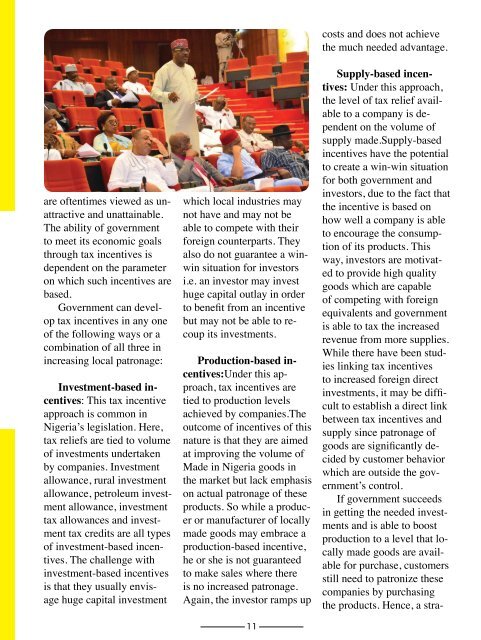boundless-volume-1
You also want an ePaper? Increase the reach of your titles
YUMPU automatically turns print PDFs into web optimized ePapers that Google loves.
are oftentimes viewed as unattractive<br />
and unattainable.<br />
The ability of government<br />
to meet its economic goals<br />
through tax incentives is<br />
dependent on the parameter<br />
on which such incentives are<br />
based.<br />
Government can develop<br />
tax incentives in any one<br />
of the following ways or a<br />
combination of all three in<br />
increasing local patronage:<br />
Investment-based incentives:<br />
This tax incentive<br />
approach is common in<br />
Nigeria’s legislation. Here,<br />
tax reliefs are tied to <strong>volume</strong><br />
of investments undertaken<br />
by companies. Investment<br />
allowance, rural investment<br />
allowance, petroleum investment<br />
allowance, investment<br />
tax allowances and investment<br />
tax credits are all types<br />
of investment-based incentives.<br />
The challenge with<br />
investment-based incentives<br />
is that they usually envisage<br />
huge capital investment<br />
which local industries may<br />
not have and may not be<br />
able to compete with their<br />
foreign counterparts. They<br />
also do not guarantee a winwin<br />
situation for investors<br />
i.e. an investor may invest<br />
huge capital outlay in order<br />
to benefit from an incentive<br />
but may not be able to recoup<br />
its investments.<br />
Production-based incentives:Under<br />
this approach,<br />
tax incentives are<br />
tied to production levels<br />
achieved by companies.The<br />
outcome of incentives of this<br />
nature is that they are aimed<br />
at improving the <strong>volume</strong> of<br />
Made in Nigeria goods in<br />
the market but lack emphasis<br />
on actual patronage of these<br />
products. So while a producer<br />
or manufacturer of locally<br />
made goods may embrace a<br />
production-based incentive,<br />
he or she is not guaranteed<br />
to make sales where there<br />
is no increased patronage.<br />
Again, the investor ramps up<br />
11<br />
costs and does not achieve<br />
the much needed advantage.<br />
Supply-based incentives:<br />
Under this approach,<br />
the level of tax relief available<br />
to a company is dependent<br />
on the <strong>volume</strong> of<br />
supply made.Supply-based<br />
incentives have the potential<br />
to create a win-win situation<br />
for both government and<br />
investors, due to the fact that<br />
the incentive is based on<br />
how well a company is able<br />
to encourage the consumption<br />
of its products. This<br />
way, investors are motivated<br />
to provide high quality<br />
goods which are capable<br />
of competing with foreign<br />
equivalents and government<br />
is able to tax the increased<br />
revenue from more supplies.<br />
While there have been studies<br />
linking tax incentives<br />
to increased foreign direct<br />
investments, it may be difficult<br />
to establish a direct link<br />
between tax incentives and<br />
supply since patronage of<br />
goods are significantly decided<br />
by customer behavior<br />
which are outside the government’s<br />
control.<br />
If government succeeds<br />
in getting the needed investments<br />
and is able to boost<br />
production to a level that locally<br />
made goods are available<br />
for purchase, customers<br />
still need to patronize these<br />
companies by purchasing<br />
the products. Hence, a stra-




